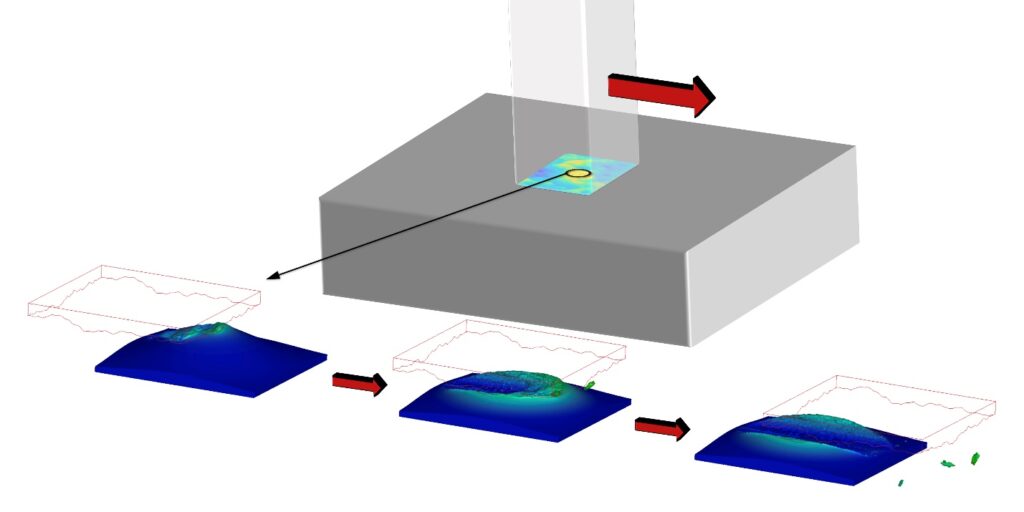PhD Student at the Luleå University of Technology (LTU), Machine Elements, Department of Engineering Sciences and Mathematics.
Understanding Wear in Micro-Scale Contacts: A Stress-State-Dependent Wear Model
Wear and tear are unavoidable consequences when surfaces come into contact, leading to performance degradation and reduced lifespan of various systems. To address this challenge, a groundbreaking study has developed a wear model that considers stress states and thermal effects at the micro-scale. By incorporating advanced numerical techniques and fracture models, researchers have made significant strides in accurately predicting wear behavior and enhancing our understanding of the complex nature of micro-scale wear phenomena.
At the micro-scale, the interaction between surfaces is influenced by factors such as surface roughness, material properties, temperature, and stress states. Predicting wear under these conditions is inherently challenging due to the interplay of multiple variables. However, the stress-state-dependent thermo-mechanical wear model, developed using the Finite Element Method (FEM), continuum damage mechanics, and thermal analysis, addresses these complexities and offers a more comprehensive understanding of wear in micro-scale contacts.
A key aspect of the wear model is the incorporation of an advanced 3D fracture model that takes into account the stress-state dependency of fractures. The fracture criteria used in the model are obtained from real tensile tests, ensuring the accuracy and reliability of the predictions. By considering the intricate behavior of fractures under different stress states, the model provides a more realistic representation of wear processes.
Figure 1. Contact cross section.
In their simulations, the researchers investigated the impact of secondary surface roughness on wear and temperature development. The results demonstrated that when a rigid body collides with an elasto-plastically deformable body, the presence of secondary roughness significantly influences wear patterns and temperature changes. This finding emphasizes the importance of considering surface characteristics in wear analysis and design, as even minor surface irregularities can have a substantial impact on wear behavior.
The study also revealed the strong dependency of wear development on the triaxiality and Lode parameters, which reflect the stress states experienced by the contacting surfaces. Surprisingly, compressive stresses were found to induce less wear compared to shear and tension. This insight is valuable for designing materials and systems that can withstand wear-related challenges and extend their operational lifespan.
Furthermore, the simulations highlighted the thermal effects associated with wear. Flash temperature increases were observed, with their magnitude influenced by the stress state. Specifically, compressive stresses led to higher temperature rises compared to shear and tension. Considering thermal effects in wear modeling is essential for understanding the overall wear behavior and its implications for material performance and system design.
The stress-state-dependent thermo-mechanical wear model presented in this study represents a significant advancement in our understanding of wear processes in micro-scale contacts. By incorporating stress states, surface roughness, and thermal effects, this model offers a comprehensive framework for predicting wear behavior. The integration of an advanced 3D fracture model, the calibration of wear coefficients using BEM, and the fusion of BEM results with FEM simulations contribute to the model’s accuracy and computational efficiency.
Figure 2. Lower surface.
Figure 3. Upper surface.
This model is a significant step towards advancing our knowledge in micro-scale wear mechanisms. It enables researchers and engineers to gain valuable insights into the wear behavior of materials at the micro-scale, paving the way for more precise wear predictions and the development of strategies to mitigate wear effects. The findings from this study have the potential to revolutionize the design and optimization of components and systems, leading to improved performance, durability, and cost-effectiveness.
To ensure the applicability of the wear model across different modeling approaches, the wear coefficients, particularly the Archard wear coefficient, are calibrated using the faster and simpler Boundary Element Method (BEM). The calibration process involves reverse engineering the Archard wear coefficient for BEM to yield wear results that closely align with the advanced FEM simulations. This calibration step enables the utilization of BEM’s computational efficiency while maintaining the accuracy and reliability of wear predictions.
The insights gained from this research have far-reaching implications across various industries, including automotive, manufacturing, and materials engineering. Accurate wear prediction and the ability to design systems that mitigate wear effects can improve component performance, enhance durability, and reduce maintenance costs. This study lays the foundation for further advancements in wear analysis and opens up new avenues for studying and addressing wear-related challenges in micro-scale contacts.
For further details please refer to the original research article.



Be the first to comment